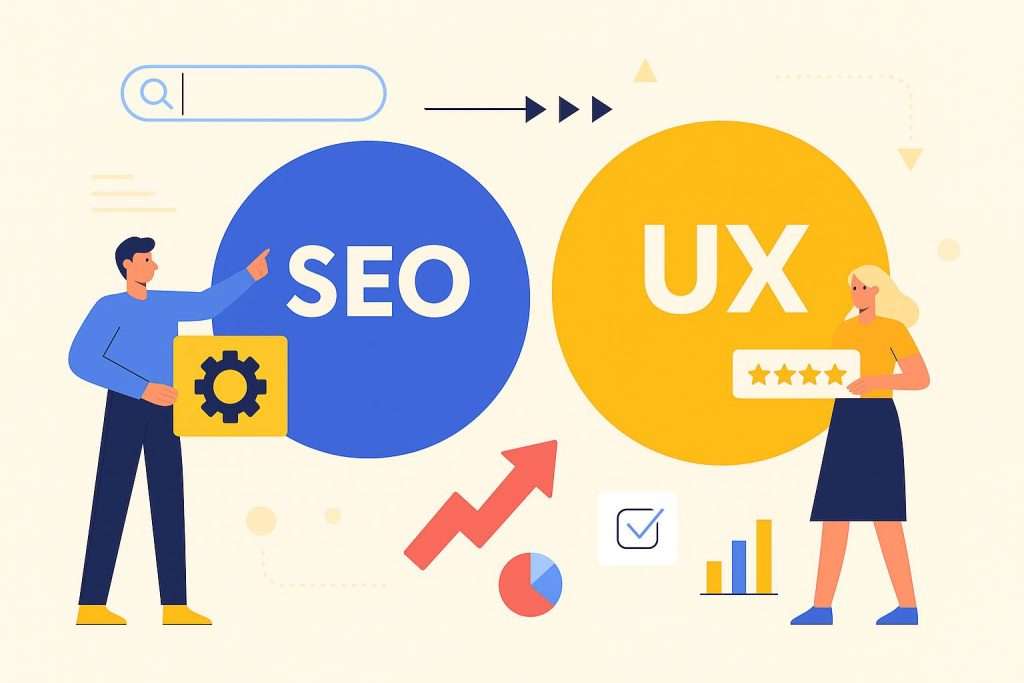User experience (UX) and search engine optimization (SEO) have evolved from separate disciplines into interconnected strategies that drive website success. Modern search engines like Google prioritize user-friendly websites, making UX an integral ranking factor rather than an optional enhancement.
This comprehensive guide explores how user experience affects SEO performance, common conflicts between these approaches, and actionable strategies to optimize both simultaneously. You’ll discover practical methods to improve page speed, mobile optimization, and website structure while maintaining strong search visibility and user satisfaction.
- Key Takeaways
- Understanding SEO and UX: Definitions and Importance
- How Search Engines Work
- The Interrelation Between SEO and UX
- Important UX Metrics That Affect SEO
- The Conflict Between UX and SEO
- UX SEO Best Practices
- Using Keyword Rank Tracker from Rush Analytics
- Testing and Iteration for Continuous Improvement
- FAQs
Key Takeaways
- UX and SEO are complementary disciplines that work together rather than competing against each other when approached strategically
- User engagement metrics directly impact SEO rankings — longer dwell times, lower bounce rates, and higher pages per session signal content quality to search engines
- Page speed optimization benefits both users and SEO — faster loading times improve user satisfaction and serve as a direct Google ranking factor
- Mobile-first optimization is essential since mobile users account for over 60% of web traffic and Google uses mobile-first indexing
- Strategic keyword usage enhances both discoverability and user experience when implemented naturally without sacrificing readability
- Accessible website design improves engagement signals that indirectly boost search visibility while serving users with disabilities
- Continuous testing and iteration are crucial for maintaining the optimal balance between user needs and search engine requirements
- Understanding search intent is fundamental to creating content that satisfies both users and algorithms simultaneously
Understanding SEO and UX: Definitions and Importance

SEO is the process of improving website visibility in organic search results to increase targeted traffic. It involves optimizing technical elements, content, and off-page factors to help search engines understand and rank your pages.
UX refers to how users interact with your website and their overall experience navigating, consuming content, and completing desired actions. It encompasses design, functionality, accessibility, and user satisfaction.
These disciplines complement each other perfectly. SEO brings qualified traffic to your site by matching search intent, while UX ensures visitors have positive experiences that encourage engagement. Studies show that good UX leads to 400% higher conversion rates, while strong SEO can increase organic traffic by 53% on average.
The fusion of these approaches, called SXO (Search Experience Optimization), represents the modern approach to website optimization that serves both users and search engines effectively. UX designers increasingly collaborate with digital marketing teams to create experiences that satisfy both human users and search algorithms.
How Search Engines Work
Search engines operate through three fundamental processes that determine which pages appear for specific queries:
Crawling: Search bots systematically discover and scan websites by following links between pages. These search engine crawlers collect information about content, structure, and technical implementation across the web.
Indexing: The collected information gets processed and stored in massive databases, creating a searchable index of web content organized by topics, keywords, and relevance signals.
Ranking: Complex algorithms analyze hundreds of factors to determine which pages best match each user’s search query. These factors include content relevance, technical performance, user engagement signals, and authority indicators.
Understanding these processes helps explain why both technical factors and user experience signals matter. Search engines aim to deliver the most relevant, highest-quality results that satisfy user intent—making UX optimization essential for ranking success.
The Interrelation Between SEO and UX

SEO and UX share a bidirectional relationship where improvements in one area boost performance in the other. Search engine algorithms now measure user engagement signals like dwell time, bounce rate, and pages per session to evaluate content quality and user satisfaction.
When users spend more time on your pages, engage with content, and navigate to additional pages, these positive signals indicate valuable content that deserves higher SEO rankings. Conversely, high bounce rates and short dwell times suggest poor user experiences that may hurt search visibility.
Effective SEO also enhances UX by bringing the right users to your site. When your content matches search intent, visitors are more likely to find what they’re seeking, leading to better engagement and conversion rates.
Research shows that improving Core Web Vitals can increase conversions by up to 12%, while sites with faster loading times see 25% lower bounce rates. This demonstrates how technical optimizations benefit both user experience and search performance simultaneously.
Important UX Metrics That Affect SEO
Several key metrics bridge the gap between user experience and search engine optimization:
Behavioral Metrics
Bounce Rate: The percentage of visitors who leave after viewing only one page. Lower bounce rates (30-50%) typically indicate engaging content that matches user intent.
Dwell Time: How long users spend on a page before returning to search engine results pages. Pages with longer dwell times often rank higher because they suggest content satisfaction.
Pages Per Session: The average number of pages viewed during a visit. Higher values indicate effective internal linking and engaging content that encourages exploration.
Click-Through Rate (CTR): The percentage of users who click your listing in search results. Higher CTRs can improve rankings by signaling relevance to search engines.
Pogo-Sticking: When users quickly bounce between search results looking for better answers. High pogo-sticking rates may indicate content that doesn’t match search intent.
Technical Metrics
Core Web Vitals: Google’s page experience signals measuring loading performance (LCP), interactivity (FID), and visual stability (CLS).
Average Engagement Time: How long users actively interact with your content, replacing the older “time on page” metric.
Internal Link Distribution: How effectively you guide users through your site architecture using strategic internal linking.
These metrics can be measured using tools like Google Analytics, Hotjar for user behavior analysis, and Microsoft Clarity for heatmaps and session recordings. Google Search Console provides additional insights into how search engines perceive your site’s performance.
The Conflict Between UX and SEO

Natural tensions can arise between optimizing for search engines versus designing for users. Understanding these conflicts helps you make informed decisions that balance both priorities effectively.
SEO sometimes focuses on algorithm requirements that may not align with natural user behavior. For example, targeting specific keyword densities might create awkward phrasing that hurts readability. Similarly, comprehensive content that ranks well might overwhelm users who prefer concise information.
UX design prioritizes human experience and emotional response, which doesn’t always align with technical optimization requirements. Minimalist designs that enhance user focus might limit internal linking opportunities or reduce keyword placement options.
UX Decisions That May Hurt SEO
Minimalist Navigation: While clean, simple menus improve user focus, they can limit internal linking opportunities that help search engines understand site structure and distribute page authority.
Dynamic Content: Personalized or JavaScript-heavy content improves user interaction but can create challenges for search engine crawling and indexing if not implemented properly.
Graphic-Heavy Design: Visual elements enhance user experience but may slow page loading and hurt Core Web Vitals scores if not optimized correctly.
Simplified URLs: User-friendly URLs benefit navigation but might sacrifice keyword inclusion that helps search engines understand page relevance.
SEO Practices That May Hurt UX
Keyword Stuffing: Overusing target keywords creates unnatural, difficult-to-read content that frustrates users and can trigger search penalties.
Excessive Internal Linking: While internal links help SEO, too many can disrupt reading flow and overwhelm users with choices.
Bloated Code: Adding multiple tracking codes, plugins, and SEO tools can slow page loading and create technical issues that hurt user experience.
Over-Optimization: Focusing too heavily on search algorithms can result in content that feels robotic rather than helpful and engaging for human readers.
UX SEO Best Practices
The most effective approach balances user needs with search engine requirements through strategies that benefit both disciplines simultaneously. Modern SEO factors increasingly reward good UX, making these complementary rather than competing priorities.
Focus on understanding what users really need when they search for your target keywords. Create content and experiences that genuinely help people achieve their goals while maintaining technical optimization fundamentals for your target audience.
Understand Search Intent
Effective optimization starts with understanding why users search for specific terms and what they hope to accomplish. Analyze search queries to identify whether users want information, navigation, or transaction opportunities.
Use keyword research tools like Google’s Keyword Planner to discover related terms and questions. Examine existing search results to understand what content formats and topics Google considers most relevant.
Conduct user research through surveys, interviews, and analytics data to validate assumptions about search intent. This ensures your content matches both algorithmic expectations and genuine user needs.
Improve Page Load Time
Page speed affects both user satisfaction and SEO rankings. Users expect pages to load within 2-3 seconds, while Google considers loading time a direct ranking factor.
Implement these specific optimizations:
- Use content delivery networks (CDNs) to serve content from locations closer to users.
- Minify CSS, JavaScript, and HTML code to reduce file sizes.
- Optimize images through compression and modern formats like WebP.
- Enable caching to store frequently accessed elements locally.
- Limit plugins and widgets that add unnecessary loading time.
- Regular updates to ensure optimal performance.
Test your site speed using Google’s PageSpeed Insights and monitor improvements over time. Walmart found that conversion rates increased by 2% for every second of improvement in loading time.
Optimize Your Website for Mobile
Mobile users account for over 60% of web traffic, making mobile optimization crucial for both UX and SEO. Google uses mobile-first indexing, meaning it primarily evaluates the mobile version of your site for rankings.
Implement responsive web design that adapts to different screen sizes automatically. Ensure text remains readable without zooming, tap targets are appropriately sized, and mobile layouts work effectively on smaller screens.
Research from the Baymard Institute shows common mobile friendliness issues include closely placed elements and inadequate keyboard layouts. Test your mobile experience using Google’s Mobile-Friendly Test and address any identified issues.
Create a User-Friendly Web Page Layout
Well-designed layouts help users find information quickly while enabling search engines to understand content structure and hierarchy.
Use limited color palettes to reduce visual complexity and cognitive load. Place important elements like navigation menus and calls-to-action in familiar locations where users expect to find them.
Implement logical information architecture with clear hierarchies. Use dropdown navigation for complex sites but ensure all important pages remain easily accessible. Include visual cues and clear CTAs to guide users through desired actions.
Simplify Your Site Navigation
Intuitive navigation benefits both users and search engines by creating clear pathways through your content and establishing page relationships and importance.
Implement a flat hierarchy where every page is accessible within 3-4 clicks from the homepage. Use descriptive menu labels that clearly explain topics and subtopics.

Ensure every page has internal links pointing to it, helping both users discover content and search engines understand site structure. Proper navigation can help Google generate sitelinks in search engine results pages while distributing link authority effectively throughout your site.
Use Relevant Keywords Throughout Your Website
Strategic keyword usage helps search engines understand content relevance while helping users find the information they’re seeking.
Focus on long-tail keywords that reflect specific user intent rather than broad, competitive terms. Incorporate keywords naturally in title tags, meta descriptions, headers, and body content without sacrificing readability.
Avoid keyword stuffing, which creates unnatural language that harms user experience and can trigger search penalties. Use synonyms and semantic variations to maintain natural flow while optimizing for related search terms.
Create Relevant, Clear, and Concise Content
Balance search engines’ preference for comprehensive information with users’ need for digestible, actionable content.
Break complex topics into smaller sections with clear subheadings. Use plain language instead of technical jargon when possible. Incorporate various content formats like infographics, videos, and bullet points to engage different learning preferences.
Focus on genuinely helpful content that addresses specific user questions and problems. This approach naturally satisfies both user needs and search engine requirements, leading to higher engagement metrics that positively influence rankings.
Use Headings to Improve Readability
Proper heading structure creates clear content hierarchy that benefits both users scanning for information and search engines understanding content organization.
Use a single H1 tag for your main topic, followed by logical H2 and H3 tags for subtopics. Avoid skipping heading levels, which can confuse both users and search engines about content relationships.
Incorporate keywords naturally in headings while maintaining clarity and readability. Well-structured headings help users quickly identify relevant sections while helping search engines understand content relevance and topical coverage.
Make Your Website Accessible
Web accessibility practices benefit users with disabilities while often improving SEO performance through better user engagement signals.
Use semantic HTML elements, ARIA roles, and alt text for images to make content accessible to assistive technologies. Implement keyboard navigation and ensure sufficient color contrast for users with visual impairments.
Google’s John Mueller notes that inaccessible sites naturally receive fewer recommendations and engagement over time, indirectly affecting search visibility. Accessible websites typically generate stronger engagement signals like longer dwell times and higher click-through rates.
Using Keyword Rank Tracker from Rush Analytics
Monitor how UX improvements affect SEO performance with Rush Analytics Rank Tracker. This essential tool helps you track your root domain’s positions in search results for target keywords, providing actionable data on ranking changes over time.
The Rank Tracker enables you to:
- Monitor keyword positions across multiple search engines and locations.
- Track ranking fluctuations and identify trends.
- Analyze the impact of UX optimizations on search visibility.
- Compare performance against competitors.
- Generate detailed reports for stakeholders.
Understanding the correlation between UX changes and ranking improvements is crucial for continuous optimization. Use ranking data to validate whether site speed improvements, mobile optimization, or navigation changes positively impact search performance.
Regular monitoring helps identify when rankings drop, allowing you to investigate whether recent UX changes inadvertently hurt SEO performance or if algorithm updates require strategy adjustments.
Free 7 days access to all tools. No credit card required!
Попробовать бесплатно
Testing and Iteration for Continuous Improvement
Effective UX SEO requires ongoing testing and refinement based on real user behavior and search engine data rather than assumptions or one-time optimizations.
Implement A/B testing to compare different versions of content, layouts, or design elements. Test one variable at a time to isolate the impact on both user engagement and search performance.
Monitor user feedback through surveys, support tickets, and analytics to identify pain points and opportunities. Use heatmaps and session recordings to understand how users actually navigate your site versus how you intended.
Adopt an agile, data-driven approach where strategies evolve based on performance metrics. For example, if heatmaps reveal navigation issues while ranking reports show keywords losing positions, you can make targeted improvements that address both concerns simultaneously.
FAQs
What is the core focus of UX design?
UX design focuses on creating positive, efficient, and satisfying experiences for users interacting with websites or applications. It prioritizes usability, accessibility, and meeting user needs through thoughtful design decisions.Can a website be optimized for SEO without compromising its UX?
Yes, modern SEO best practices align with good user experience. Search engines reward sites that provide value to users, making UX optimization beneficial for both user satisfaction and search rankings.What are some common conflicts between UX design and SEO strategy?
Common conflicts include keyword usage versus natural language, comprehensive content versus simplicity, and minimalist design versus technical optimization requirements. These tensions can be balanced through strategic planning and testing.






